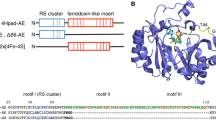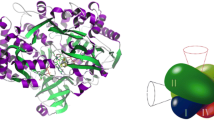Abstract
Acetyl-CoA synthase (also known as carbon monoxide dehydrogenase) is a bifunctional Ni-Fe-S-containing enzyme that catalyzes the reversible reduction of CO2 to CO and the synthesis of acetyl-coenzyme A from CO, CoA, and a methyl group donated by a corrinoid iron-sulfur protein. The active site for the latter reaction, called the A-cluster, consists of an Fe4S4 cubane bridged to the proximal Ni site (Nip), which is bridged in turn to the so-called distal Ni site. In this review, evidence is presented that Nip achieves a zero-valent state at low potentials and during catalysis. Nip appears to be the metal to which CO and methyl groups bind and then react to form an acetyl-Nip intermediate. Methyl group binding requires reductive activation, where two electrons reduce some site on the A-cluster. The coordination environment of the distal Ni suggests that it could not be stabilized in redox states lower than 2+. The rate at which the [Fe4S4]2+ cubane is reduced is far slower than that at which reductive activation occurs, suggesting that the cubane is not the site of reduction. An intriguing possibility is that Nip2+ might be reduced to the zero-valent state. Reinforcing this idea are Ni-organometallic complexes in which the Ni exhibits analogous reactivity properties when reduced to the zero-valent state. A zero-valent Ni stabilized exclusively with biological ligands would be remarkable and unprecedented in biology.





Similar content being viewed by others
References
Lindahl PA (2002) Biochemistry 41:2097–2105
Wood HG, Ljungdahl LG (1991) In: Shively JM, Barton LL (eds) Variations in autotrophic life. Academic Press, New York, pp 201–250
Lindahl PA, Chang B (2001) Origins Life Evol Biosphere 31:403–434
Doukov TI, Iverson TM, Seravalli J, Ragsdale SW, Drennan CL (2002) Science 298:567–572
Darnault C, Volbeda A, Kim EJ, Legrand P, Vernede X, Lindahl PA, Fontecilla-Camps JC (2003) Nat Struct Biol 10:271–279
Svetlitchnyi V, Dobbek H, Meyer-Klaucke W, Meins T, Thiele B, Römer P, Huber R, Meyer O (2004) Proc Natl Acad Sci USA 101:446–451
Echols N, Milburn D, Gerstein M (2003) Nucleic Acids Res 31:478–482
Krebs WG, Gerstein M (2000) Nucleic Acids Res 28:1665–1675
Seravalli J, Gu W, Tam A, Strauss E, Begley TP, Cramer SP, Ragsdale SW (2003) Proc Natl Acad Sci USA 100:3689–3694
Gencic S, Grahame DA (2003) J Biol Chem 278:6101–6110
Bramlett MR, Tan X, Lindahl PA (2003) J Am Chem Soc125:9316–9317
Seravalli J, Xiao Y, Gu W, Cramer SP, Antholine WE, Krymov V, Gerfen GJ, Ragsdale SW (2004) Biochemistry 43:3944–3456
Krüger HJ, Peng G, Holm RH (1991) Inorg Chem 30:734–742
Hanss J, Krüger HJ (1998) Angew Chem Int Ed 37:360–363
Marlin DS, Mascharak PK (2000) Chem Soc Rev 29:69–74
Harrop TC, Olmstead MM, Mascharak PK (2002) Inorg Chim Acta 338:189–195
Loke HK, Bennett B, Lindahl PA (2000) Proc Natl Acad Sci USA 97:12530–12535
Loke HK, Tan X, Lindahl PA (2002) J Am Chem Soc 124:8667–8672
Lindahl PA, Ragsdale SW, Münck E (1990) J Biol Chem 265:3880–3888
Xia J, Hu Z, Popescu C, Lindahl PA, Münck E (1997) J Am Chem Soc 119:8301–8312
Fan CL, Gorst CM, Ragsdale SW, Hoffman BM (1991) Biochemistry 30:431–435
Shin W, Lindahl PA (1992) Biochemistry 31:12870–12875
Russell WK, Stålhandske CMV, Xia J, Scott RA, Lindahl PA (1998) J Am Chem Soc 120:7502–7510
Lindahl PA, Münck E, Ragsdale SW (1990) J Biol Chem 265:3873–3879
Shin W, Lindahl PA (1992) J Am Chem Soc 114:9718–9719
Shin W, Anderson ME, Lindahl PA (1993) J Am Chem Soc 115:5522–5526
Schenker RP, Brunold TC (2003) J Am Chem Soc 125:13962–13963
Stavropoulos P, Muetterties MC, Carrie M, Holm RH (1991) J Am Chem Soc 113:8485–8491
Stoppioni P, Dapporto P, Sacconi L (1978) Inorg Chem 17:718–725
Pezacka E, Wood HG (1988) J Biol Chem 263:16000–16006
Lu WP, Harder SR, Ragsdale SW (1990) J Biol Chem 265:3124–3133
Barondeau DP, Lindahl PA (1997) J Am Chem Soc 119:3959–3970
Tan X, Sewell C, Yang Q, Lindahl PA (2003) J Am Chem Soc 125:318–319
Kumar M, Qiu D, Spiro TG, Ragsdale SW (1995) Science 270:628–630
Lebertz H, Simon H, Courtney LF, Benkovic SJ, Zydowsky LD, Lee K, Floss HG (1987) J Am Chem Soc 109:3173–3174
Tan X, Sewell C, Lindahl PA (2002) J Am Chem Soc 124:6277–6284
Webster CE, Darensbourg MY, Lindahl PA, Hall MB (2004) J Am Chem Soc 126:3410–3411
Hsiao Y-M, Chojnacki SS, Hinton P, Reibenspies JH, Darensbourg MY (1993) Organometallics 12:870–875
Wang Q, Blake AJ, Davies ES, McInnes EJL, Wilson C, Schröder M (2003) Chem Commun 24:3012–3013
Musie G, Farmer PJ, Tuntulani T, Reibenspies JH, Darensbourg MY (1996) Inorg Chem 35:2176–2183
Linck RC, Spahn CW, Rauchfuss TB, Wilson SR (2003) J Am Chem Soc 125:8700–8701
Krishnan R, Riordan CG (2004) J Am Chem Soc 126:4484–4485
Tolman CA, Seidel WC, Gosser LW (1974) J Am Chem Soc 96:53–60
Daniele S, Martelli M, Bontempelli G (1991) Inorg Chim Acta 179:105–111
Acknowledgements
Many of the developments described here could not have been made without the efforts of Juan C. Fontecilla-Camps and his group in Grenoble. Discussions with Marcetta Y. Darensbourg and Michael B. Hall were critical in developing the Ni0 hypothesis. The author thanks his co-workers at Texas A&M who worked on problems related to this hypothesis over the past decade or so, including Woonsup Shin, David P. Barondeau, Xiangshi Tan, and Matthew R. Bramlett. Thanks are also due to Mark Gerstein and co-workers (Yale University) for preparing the movie of the α subunit conformations. This project is supported by the National Institutes of Health (GM46441).
Author information
Authors and Affiliations
Corresponding author
Electronic Supplementary Material
Rights and permissions
About this article
Cite this article
Lindahl, P.A. Acetyl-coenzyme A synthase: the case for a Nip0-based mechanism of catalysis. J Biol Inorg Chem 9, 516–524 (2004). https://doi.org/10.1007/s00775-004-0564-x
Received:
Accepted:
Published:
Issue Date:
DOI: https://doi.org/10.1007/s00775-004-0564-x




